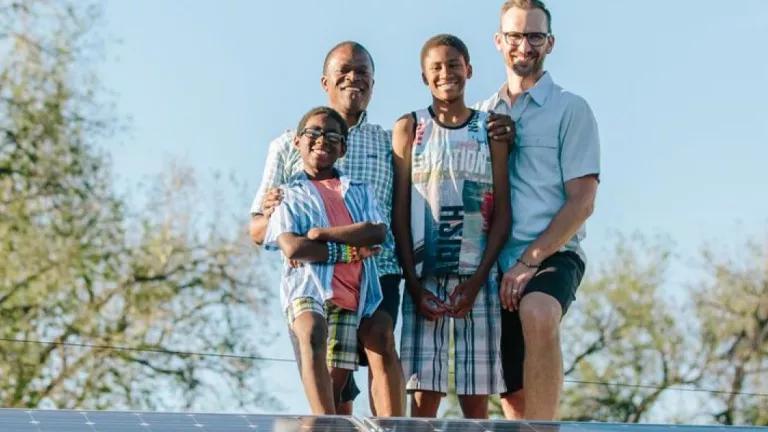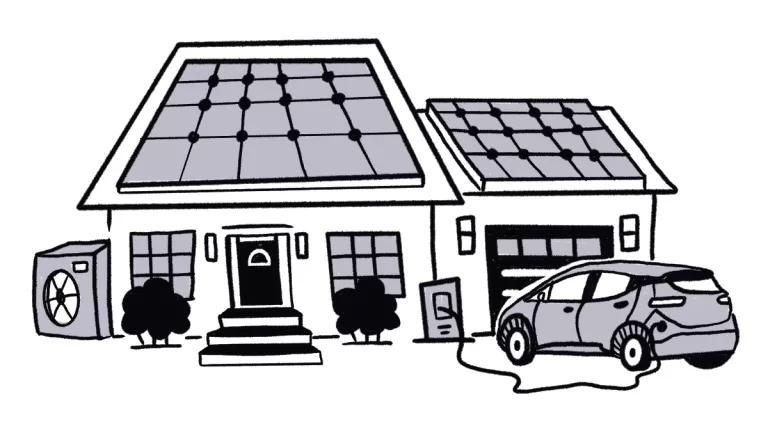The Kansas Energy Story—and Opportunity
Kansas may not be the first state that comes to mind when you think “renewable energy powerhouse”—but it has become one.

Smoky Hills Wind Farm
Kansas may not be the first state that comes to mind when you think “renewable energy powerhouse”—but it has become one.
Kansas currently generates over 40 percent of the state’s electricity from wind. The Kansas City metropolitan area has also developed a Climate Action Plan with the goal of net-zero greenhouse gas emissions by 2050 and decarbonizing the building sector by 2040. Recently, the state took a major step toward that clean energy future with the passage of securitization legislation.
With the passage of securitization legislation, Kansas utilities can address the sunk costs associated with uneconomic coal generation and move aggressively toward net-zero carbon emissions from the power sector. An equitable economic recovery for all communities in Kansas—powered by clean energy and paired with investments in our buildings and infrastructure—will result in robust economic growth for decades, lots of well-paying jobs, and a healthy environment for all.
The Story: Clean Energy
Kansas wind resources grew from generating <1 percent of the state’s electricity in 2005 to more than 40 percent today. This increased share of wind on the Kansas grid has contributed to the state cutting their carbon emissions nearly in half, over the same period. Located in the nation’s so called, “Wind Belt,” Kansas is home to some of the most abundant wind resources in the world, and is uniquely positioned to become even a larger contributor to the national renewable energy generation mix.


Wind power in Kansas not only contributes to significant carbon reductions, but it is also great for the Kansas economy. This rapid growth in wind energy has already created more than 22,000 jobs within the state and generated millions in tax revenue. In fact, clean power investments in Kansas communities generated more than $31 million of property, state, and local taxes in 2020 alone. Wind energy is also cheaper to generate than coal and, in most cases, natural gas. The economic benefits are so significant that a recent effort to stymie wind growth was met with staunch opposition on both sides of the aisle. Solar also has an important role to play in Kansas, as this renewable resource, while not as prevalent at present, would generate electricity at different times of day and year than wind resources. This complimentary clean resource can significantly help enhance reliability.
The transition to renewable energy makes economic sense. However, without proper protection, utility customers could be in danger of paying for lower cost renewable development as well as the sunk costs for the more expensive traditional fossil power assets. That is where securitization legislation comes in. Securitization is a tool which allows utilities to access low-cost financing so they can accelerate the transition from more expensive generation to less expensive resources like wind and solar, while reducing costs for all electricity consumers.
When an uneconomical resource, like a coal-fired power plant, comes offline before the plant itself has been fully paid off, that unrecovered cost is still something that utility customers end up paying for. Securitization shrinks those costs, creating a win-win for the utility and its customers. Consumers will no longer be asked to pay for both investments in new less expensive renewables and retiring fossil-power assets at the same time.
With these sunk costs coming off their books, utilities have more room in their budgets to continue to grow their renewable assets, while allowing customers to reap the benefits of low-cost clean energy.
The Story: Infrastructure
While a fantastic tool for cost recovery, securitization alone will not be enough to transition Kansas to 100 percent clean energy. The state will also need to address the transmission and storage of renewable resources. This is necessary to not only address carbon emissions but also provide important reliability and affordability benefits.
Transmission refers to the power lines that physically connects energy generation to the end consumer. To best utilize the abundant wind energy generated in Kansas, more regional transmission will be required. Such transmission is key for getting wind energy out of Kansas when there is an excess of supply and importing low-cost energy into the state when generation is low or extreme weather increases demand. In addition to allowing Kansas to earn income from exporting power, greater transmission can increase the grid’s reliability and lower cost of transmission for Kansas consumers. That means more affordable power to the places that need it and fewer outages—even in extreme weather conditions.

Two regional transmission organizations (RTOs), Southwest Power Pool (SPP) and Midcontinent ISO (MISO), are responsible for managing energy flow across much of the Midwest. SPP and MISO are linked to each other with regional transmission lines, however, the current extent of this regional transmission is minimal. With greater connectivity, the economic and energy reliability benefits of transmission could be enhanced. The major barrier to such expansion is cost allocation, i.e., who pays for the transmission that runs through their state. Regional efforts to address these cost allocation concerns would benefit from federal action.
Storage is an important compliment to transmission which assists with reliability. Storage is most beneficial to help balance the load, ensuring energy supply can be shifted to match demand. The good news is the cost of utility-scale storage is declining fast! From 2015 to 2018, storage costs dropped 70 percent. As the price of this solution continues to decrease, the potential for a cleaner, more reliable grid becomes increasingly cost-effective. Fully realizing the reliability benefits of storage will be enhanced through federal storage tax credits or a similar financial mechanism.
The Story: Buildings and Transportation
The power sector is not the only place Kansas can and must decarbonize to achieve a net-zero by midcentury climate goal. Net-zero buildings and transportation represent a growing area of focus in this region and is rife with opportunities.
Decarbonizing the building sector can be a daunting task. It involves a combination of energy efficiency, low and zero carbon space heating (e.g., heat pumps), and distributed renewable energy generation. Such initiatives support local jobs, improve air quality, enhance affordability, and increase property value—all while combating climate change!
That is why we have prioritized the creation of building energy hubs in Kansas City metro and elsewhere, modeled after the Building Energy Exchange (BE-Ex) in New York. Once fully operational, BE-Ex KC will provide building owners, especially those in low-income communities, with technical assistance, financing help (including accessing utility incentives), and hand holding to help achieve their decarbonization goals. BE-Ex KC will also work on policy issues such as benchmarking, building codes, and building decarbonization solutions. Projects like BE-Ex KC compliment NRDC’s traditional decarbonization approach, (i.e., utility efficiency investments, building codes, and appliance standards) with strategies to help speed up market transformation and support community partners on the ground.

Electric vehicles (EVs) are growing in popularity and presence on the road. While this transition is good for local air quality, human health, and the climate while saving drivers money, EV adoption has the potential to disrupt the current automotive manufacturing industry. Europe and China currently lead on EV adoption and the manufacturing that goes along with it, while the U.S. lags in both respects. That is, unless the state and federal government does more to incentivize domestic manufacturing and adoption.
If the U.S. waits until the last minute to invest in the domestic EV supply chain, consumers will have fewer domestic car buying options and the U.S. automotive manufacturing industry will find themselves behind the competition. Thankfully, President Biden addresses domestic EV jobs specifically in his proposed American Jobs Plan. If states like Kansas can position themselves as leaders in EV supply chain manufacturing, they can help existing and new Kansas workers as they create the vehicles and components which will move us forward into a cleaner, healthier future.
The Opportunity
A decarbonized Kansas electricity sector that benefits all consumers can be achieved through securitization and fossil fuel retirement, wind and solar buildout, and the development of reliable transmission and affordable storage. These efforts will make it easier to decarbonize buildings, as the energy going into them is carbon free. When our buildings are more energy efficient, they will use less of that clean energy, freeing it up for other uses—like powering our electric cars, buses, and trucks. Each piece of the puzzle fits together to create a single vision: Kansas as a climate leader, with clean air, and a thriving economy.
Kansas is well positioned to grow its economy and jobs in an equitable manner with investments in wind, transmission, and storage in rural areas - and solar installations and efficient buildings everywhere. This will not only help reduce the energy burden faced by many Kansans but also make our businesses more competitive. As we move toward net-zero by 2050, Kansas is also well positioned to be a leader on new and developing economic opportunities such as green hydrogen, ag-based sequestration, and clean energy supply chains. The opportunities are abundant for Kansas—now we just need to seize them.




